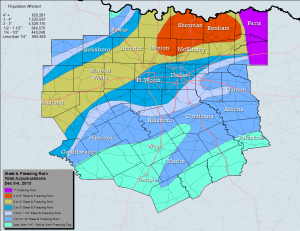Please check out the informative article Meteorologist Chris Robbins wrote over at iWeatherNet on the incredible rains we have received throughout 2015, including the fact that November came in as the wettest November in DFW history. Lots of great climatological data and analysis presented here:
Category Archives: Historical
IT’S OFFICIAL – DFW RECORDS ITS WETTEST YEAR OF RECORD
Out of 117 years of weather records, dating back to September of 1898, DFW records its wettest year on record officially today. With 55.30 inches of rain (as of 8am on Friday, November 27, 2015) this shatters the old record of 53.54 inches set in 1991 with the month of December left to go.
OCTOBER 2015 THE 2ND WETTEST OCTOBER ON RECORD
October 2015 has come in as the second wettest October on record. The top five wettest Octobers are:
- 1981 – 14.18 inches
- 2015 – 9.82 inches
- 1919 – 9.44 inches
- 1991 – 9.32 inches
- 1959 – 9.22 inches
This brings the total for the year 2015 to 48.93 inches of precipitation, making it, so far, the sixth wettest year in DFW weather records.
October 2015 came in with a mean average temperature of 71.2°F, making it the 12th hottest October on record. This puts the year 2015 so far in the running, with an annual average mean temperature of 69.3°F, as being the hottest year on record for DFW.
RECORD HEAT AGAIN TODAY AND TOMORROW AT DFW
The record high for DFW for today, October 14th is 99°F set in 1910. The record for tomorrow, October 15th is 92°F set in 1999. Forecasted temperatures are to be in the 97°F to 100°F range for today and tomorrow. Likely making both records in jeopardy. The hottest day will likely be today given the strength of the overhead ridge and the southwest/westerly downslope components to the winds. If we reach 100°F today, it will set an all time record for the latest DFW has ever hit the triple digits by a wide margin. That would truly be an incredible feat! Given that is almost a 40°F diurnal temperature difference (extremely rare for us), and more characteristic of a desert climate, means we will probably stay just under the century mark. Tomorrow should be a degree or so cooler as the upper ridge weakens a tad, but the record is only 92°F, and that is a certainty it will be broken, as forecasted highs will be in the upper 90s, yet again. A cold front is on tap for Friday, but given how dry we are ahead of it, it will not produce any rain. However, it will lower temperatures significantly over the weekend with lows in the low 50s and highs struggling to reach 80°F, making for a truly nice autumn weekend. A stronger trough and system looks promising for the middle of next week for the best rain chances in awhile and a more significant autumn cool down, but more on that later.
NEAR RECORD HEAT POSSIBLE NEXT SUNDAY AND MONDAY FOR DFW
The record high temperature for DFW for Sunday, October 11th is 99°F and for Monday, October 12th is 97°F. Current forecast models are predicting high temperatures approaching 100°F across the area on these dates. If temperatures were to actually hit 100°F at DFW, it would not only be the hottest temperature for these dates, but also the latest on record that we have ever hit the triple digits. Currently, the latest we have ever hit triple digits at DFW is 106°F set on October 3, 1951. Currently, it looks as though temperatures may stay just below the century mark on both dates, but records could be tied or threatened. This is definitely some hot October weather!
CHRISTMAS DAY SIGNIFICANT WEATHER EVENTS AT DFW
- 2009 – Snow remained on the ground from the Christmas Eve blizzard.
- 2000 – Record rainfall of nearly 2″ fell during the evening with temperatures from 32°F to 34°F with some minor freezing rain. However, severe freezing rain occurred north and northeast of the Metroplex.
- 1997 – A few flurries were mixed with rain during the evening. The next morning a blanket of up to ½” of snow covered portions of the Metroplex.
- 1975 – 0.4″ of snow fell on the first almost white Christmas in nearly 50 years.
- 1974 – A trace of sleet was reported.
- 1963 – No snow remained from a 2″ snowfall on December 22.
- 1929 – One of the heaviest snow events in Texas history occurred on December 21. From Clifton to Hillsboro, 24-26 inches of snow fell. A long swath of snowfall in excess of 12 inches stretched from Goldthwaite and Lampasas to Corsicana and Athens. The Waco and Temple/Killeen areas saw 10-16 inches of snow, but only a trace of snow was recorded in Dallas/Fort Worth.
- 1926 – 2″ of snow fell in Fort Worth but melted by afternoon. Dallas received 6.3″ of snow.
- 1914 – There was a trace of snow recorded with a few brief flurries.
- 1887 – A severe ice storm occurred on December 23, resulting in numerous downed trees and telegraph lines. Heavy snow followed on Christmas Eve, with as much as 9 inches falling in Palestine.
- 1879 – 1″ of sleet and snow was on the ground. It was said that the snow and sleet was so compacted that a horse’s hoof did not leave an imprint in the snow.
- 1841 – Three soldiers from a nearby fort were tracking a bear in 6″ of snow near what is now White Rock Lake.
DFW SIGNIFICANT WEATHER EVENTS ON CHRISTMAS EVE
- 2009 – Rare blizzard conditions impacted portions of North Texas. As much as 9 inches of snow fell in Jacksboro and Bowie, and winds in excess of 50 mph resulted in drifts of 3 to 5 feet. For Dallas/Fort Worth, it was the first measurable Christmas Eve snowfall on record.
- 2002 – There were a few snow flurries across North Central Texas on Christmas Eve. Many locations in the Dallas/Fort Worth Metroplex reported light snow.
- 1975 – Following a continuous cold rain most of the day, a trace of flurries was recorded. Most of the snow melted as it fell.
- 1963 – 2″ of snow had fallen on December 22. 1″ remained on the following day, the day prior to Christmas Eve, but only a trace remained on Christmas Eve with a low of 22°F.
- 1955 – This hot day reached a record high of 88°F.
- 1943 – Flurries fell from 7:30-8:00 PM. There was little accumulation after a sub-freezing day (28°F-32°F) with 0.15″ of freezing rain.
DECEMBER 18, 1983 – THE 31st ANNIVERSARY OF THE HISTORICAL COLD SNAP
On December 18, 1983, one of the severest Arctic cold snaps in modern day plunged into Texas. The mercury dipped below freezing at 7:00 am on December 18th and remained below freezing until 2:00 pm, December 30th, for a record of 295 consecutive hours of freezing/subfreezing temperatures. This of course made December 1983 the coldest December on record for Dallas/Fort Worth with an average monthly temperature of 34.8°F. This is 12.1°F below normal for the month and 4°F colder than any other cold December of record. The coldest temperatures recorded during this period was 5°F on December 22, 1983.
The area experienced a series of Arctic cold fronts beginning on the 15th, 18th, 21st, 24th, and 28th. The Arctic front on the 18th was the most significant. Cloud cover played a role in insolating the area, combined with a very low sun angle so close to the solstice, inhibiting any warming, and allowing the mercury to stay below freezing for several days. The cloud cover also kept temperatures from totally bottoming out, as had skies cleared totally, temperatures likely would have fallen below zero (in fact, Glen Rose, Tx did on the 30th with a low of -2°F). Therefore, this cold snap did not bring DFW its coldest low temperatures for December. That happened a few years later for DFW in December 1989, during another historic cold snap. The coldest temperature recorded was -1°F during 1989. However, from the 22nd through the 25th of 1983, the high temperatures failed to rise above 19°F with the coldest high reported on Christmas Eve of 13°F. This was the second coldest high temperature in DFW weather recorded history. This cold snap brought us 5 daily low temperature records that still stand to this day, and 6 daily high maximum low temperature records. Behind the Arctic front on the 24th, DFW set its all time highest barometric pressure of 31.06 inHg. The cold spell was preceded by a significant winter storm on the 15th and 16th of the month that brought a snowpack to North Texas, which aided in the severity of the cold. Many sites still had snow on the ground by the end of the month. Officially, DFW Airport reported two inches of snow with this event.
The deep freeze reached all the way into Northern Mexico, with severe freezes into the Lower Rio Grande Valley causing tens of millions of dollars worth of damage to the agriculture and farming industries. Thirteen people statewide, six in North Texas alone, were said to have lost their lives due to the cold. $1.5 million dollars damage was done to city pipes in North Texas alone, not including damage to homes and businesses from busted pipes. It was estimated that the damage to agriculture in North Texas was around $50 million.
REMEMBERING THE “COBBLESTONE” ICE STORM THAT HIT DFW ONE YEAR AGO
The following article was written and published by the National Weather Service office in Fort Worth, Texas.
A major winter storm gripped most of North and Central Texas from December 5th through the 10th, 2013, severely impacting travel and power throughout the region. Freezing rain, sleet, and a little snow began falling during the afternoon of the 5th, and persisted through the morning hours of the 6th. As dawn broke on December 6th, a thick layer of ice encased much of North and Central Texas. Just about everyone north of a Goldthwaite to Hillsboro to Palestine line had ice on the ground at this point, including the entire DFW Metroplex. Sleet and ice measured as deep as 5″ in some areas, particularly in a swath extending from Denton, through Sherman, to Bonham.

Ice accretion amounts across DFW from the “Cobblestone” ice storm that hit the area exactly one year ago. Map courtesy of the National Weather Service Office in Fort Worth, Texas.
As challenging as these fresh accumulations were for residents and travelers, the prolonged cold would make things worse. Temperatures dropped below freezing late in the day on the 5th, and would remain in the ice box for most of the next 5 days. The recurring combination of tire compaction, melting/re-freezing, and sand treatment would transform the initial frozen precipitation into rock hard formations, which would eventually be referred to as “cobblestone ice”. Most area streets and highways in the Metroplex and points north were subjected to these challenging conditions, forcing residents to remain at home for several days. Further south, conditions were a bit better, though ice did linger on bridges, overpasses, and elevated surfaces. Hundreds of cars and trucks were stranded for long periods on many of the main highways, particularly Interstate 35 from Fort Worth to the Oklahoma border, and Interstate 20 from Fort Worth going west.
While travel disruption was a major impact from this winter storm, power and property were others. Thousands of tree branches and power lines were downed by the weight of ice, particularly from Fort Worth, north and east to Paris. At the peak of the storm, 275,000 customers were without power in the North Texas region. Ice-laden tree branches crashed into vehicles, homes and other structures, sending thousands of residents scrambling for their insurance adjusters. Early estimates from the Insurance Council of Texas topped $30 million in residential insured losses. This figure did not include damage to vehicles or roads. Many roads and bridges were directly damaged from the ice – or from attempts to remove the ice using plows and graders. The clean-up from this event took weeks and even a few months in some places.
Most schools, especially in the hardest hit areas, were closed for several days, and thousands of businesses were forced to close for at least a day or two. Airlines at DFW Airport and Dallas Love Field cancelled hundreds of flights, and thousands of flyers were sheltered at both airports during the storm. Seven fatalities occurred during this event; 4 in vehicles, 2 from exposure, and 1 from a fall on the ice. Hundreds of injuries were also reported due to falls on the ice.
A Little More About Cobblestone Ice. Why Did It Form?
One of the most memorable aspects of this particular storm was the introduction of “cobblestone ice” into the common vocabulary of North Texans. So why did it form, and why did it get so bad?
First off, it goes without saying that there was an abundance of precipitation with this event. Many areas received over an inch of liquid, including DFW Airport, where 1.25” of liquid was observed. North and east of the Metroplex, totals were even higher. This translated into multiple inches of snow, sleet and/or freezing rain which existed in layers of varying depth. As traffic and marginal air and ground temperatures began to work on this frozen mess, some of it melted partially and morphed into slush during the daytime hours. Once nighttime fell, however, most of it would refreeze and harden. Despite the best efforts of local and state road crews, this cycle of compaction, melting, refreezing and hardening repeated itself in some areas over a period of up to 4 days.
In some spots, particularly on bridges and overpasses, larger chunks of ice were broken out of the icepack by plows and traffic. These chunks would mix in with the slush during the daytime, forming a soupy gray mess. At night, the entire concoction would refreeze, producing large molded bumps that were essentially glued to the very top of the roadways (or bridge decks). It was these hard, rock-like formations that represented the essence of the cobblestone ice experience for North Texas drivers.
Once frozen in place, this unique ice proved quite difficult to remove. Depths ranged from ½” to 4”, depending on where traffic caused peaks and valleys in the slush before it froze into cobblestone form.
While not a frequent occurrence, winter precipitation is no stranger to North and Central Texas. Fortunately, the cobblestone ice phenomenon is quite unusual. In addition to the magnitude of ice, it was the sustained period of cold temperatures following the event – interspersed with episodes of melting – that promoted the rough driving conditions. The only sure way to prevent this from happening in the future will be to remove most of the sleet and snow from the roadways before it gets a chance to melt and refreeze. Unfortunately, it may be difficult for local and state public works and transportation departments to achieve this lofty goal, given the thousands of miles of roadways under their jurisdictions. Having said this, local cities and counties, the State of Texas, and the National Weather Service in Dallas/Fort Worth did learn a great deal from the December 6th, 2013 storm – and these lessons will surely benefit all of North and Central Texas during future events.
THANKSGIVING DAY HISTORICAL SIGNIFICANT WEATHER EVENTS FOR DFW
- November 22, 2007 – A light wintry mix of sleet and snow fell during a cold afternoon. It was only the second occasion that wintry precipitation fell during a home Dallas Cowboys football game (vs. New York Jets).
- November 25, 1993 – Freezing rain and sleet fell during a subfreezing afternoon, amounting to 0.3″ on the ground. This was the first time that wintry precipitation was ever recorded on Thanksgiving. The low was 23°F and the high was only 35°F, making it the coldest Thanksgiving ever. Also, the annual Thanksgiving Day Dallas Cowboys football game (vs. Miami Dolphins) was the first time wintry precipitation fell during an NFL game in Dallas.
- November 25, 1965 – This hot day reached a record high of 88°F.
- November 22, 1945 – It was the first killing frost of the winter of 1945-46, a low temperature of 31°F.
- November 30, 1905 – The first killing frost of the season was a hard freeze, a morning low of 23°F.


